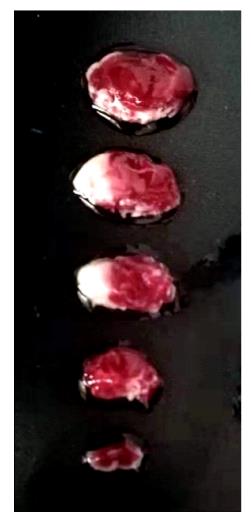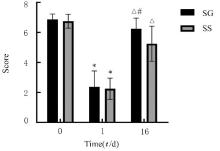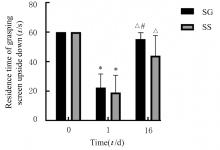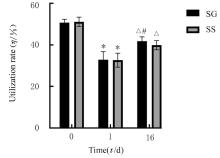| 1 |
MEURER W J, BARTH B E, GADDIS G, et al. Rapid systematic review: intra-arterial thrombectomy (“clot retrieval”) for selected patients with acute ischemic stroke[J].J Emerg Med,2017,52(2): 255-261.
|
| 2 |
孙晓静, 张 皓. 生长激素在神经系统疾病治疗中的作用[J]. 中国康复理论与实践, 2015, 21(1): 54-57.
|
| 3 |
ARCE V M, DEVESA P, DEVESA J. Role of growth hormone (GH) in the treatment on neural diseases: from neuroprotection to neural repair[J]. Neurosci Res, 2013, 76(4): 179-186.
|
| 4 |
BIANCHI V E, LOCATELLI V, RIZZI L.Neurotrophic and neuroregenerative effects of GH/IGF1[J]. Int J Mol Sci, 2017, 18(11): 2441.
|
| 5 |
SANCHEZ-BEZANILLA S, ÅBERG N D, CROCK P,et al. Growth hormone treatment promotes remote hippocampal plasticity after experimental cortical stroke[J]. Int J Mol Sci, 2020, 21(12): 4563.
|
| 6 |
ONG L K, CHOW W Z, TEBAY C, et al. Growth hormone improves cognitive function after experimental stroke[J]. Stroke, 2018, 49(5): 1257-1266.
|
| 7 |
SONG J, PARK K, LEE H, et al. The effect of recombinant human growth hormone therapy in patients with completed stroke: a pilot trial[J]. Ann Rehabil Med, 2012, 36(4): 447-457.
|
| 8 |
刘海涛, 白宏英, 曾志磊, 等. 重组人生长激素对脑缺血/再灌注损伤细胞凋亡及Nestin表达的影响[J]. 中国实用神经疾病杂志, 2010, 13(1): 39-41.
|
| 9 |
LONGA E Z, WEINSTEIN P R, CARLSON S, et al. Reversible middle cerebral artery occlusion without craniectomy in rats[J]. Stroke, 1989, 20(1): 84-91.
|
| 10 |
俞 璐, 曹晓华, 夏 明. 大鼠局灶性脑缺血模型神经功能缺损行为学评价工具的研究进展[J]. 神经损伤与功能重建, 2017, 12(6): 536-539.
|
| 11 |
DEACON R M. Measuring the strength of mice[J]. J Vis Exp, 2013(76): 2610.
|
| 12 |
SANCHEZ-BEZANILLA S, ÅBERG N D, CROCK P,et al. Growth hormone promotes motor function after experimental stroke and enhances recovery-promoting mechanisms within the peri-infarct area[J]. Int J Mol Sci, 2020, 21(2): 606.
|
| 13 |
李 论. 重组人生长激素的临床应用和研究进展[J]. 国际儿科学杂志, 2017, 44(8): 547-550.
|
| 14 |
WALSER M, SVENSSON J, KARLSSON L, et al. Growth hormone and neuronal hemoglobin in the brain-roles in neuroprotection and neurodegenerative diseases[J]. Front Endocrinol (Lausanne), 2021, 11: 606089.
|
| 15 |
缪 培, 张 通, 米海霞. 基于线栓法大鼠大脑中动脉闭塞的局灶性脑缺血模型的比较研究[J]. 中国康复理论与实践, 2016, 22(10): 1190-1195.
|
| 16 |
LI S, FRANCISCO G E. New insights into the pathophysiology of post-stroke spasticity[J]. Front Hum Neurosci, 2015, 9: 192.
|
| 17 |
袁栋才, 张凤春, 魏 巍, 等. 神经可塑性与脑卒中后运动功能恢复的研究进展[J]. 中国康复医学杂志, 2014, 29(4): 391-394.
|
| 18 |
朱 晗, 赵 华. 外源性生长激素对运动大鼠骨骼肌形态和代谢机能的影响[J]. 北京体育大学学报, 2011, 34(6): 45-49.
|
| 19 |
HEREDIA M, FUENTE A, CRIADO J, et al. Early growth hormone (GH) treatment promotes relevant motor functional improvement after severe frontal cortex lesion in adult rats[J]. Behav Brain Res, 2013, 247: 48-58.
|
| 20 |
张翠玲, 李丽娟, 刘 立. 药物干预对大鼠脑缺血后神经再塑及功能恢复的实验研究[J]. 中国现代药物应用, 2008, 2(23): 7-10.
|
| 21 |
WAN K X, MAO F X, LI Q Q, et al. Neuritin-overexpressing transgenic mice demonstrate enhanced neuroregeneration capacity and improved spatial learning and memory recovery after ischemia-reperfusion injury[J]. Aging, 2020, 13(2): 2681-2699.
|
| 22 |
CHOI D H, LEE K H, LEE J. Effect of exercise-induced neurogenesis on cognitive function deficit in a rat model of vascular dementia[J]. Mol Med Rep, 2016, 13(4): 2981-2990.
|
| 23 |
MARTE A, MESSA M, BENFENATI F, et al. Synapsins are downstream players of the BDNF-mediated axonal growth[J].Mol Neurobiol,2017,54(1): 484-494.
|
| 24 |
高蓓瑶, 江 山, 谢欲晓. 脑卒中后运动功能代偿和神经可塑性机制[J]. 中国康复医学杂志, 2021, 36(8): 1015-1020.
|
| 25 |
JIAO Y, LIU Y W, CHEN W G, et al. Neuroregeneration and functional recovery after stroke: advancing neural stem cell therapy toward clinical application[J]. Neural Regen Res, 2021, 16(1): 80-92.
|
| 26 |
凌梦钰, 杨一卓, 刘 帅, 等. 运动训练对脑缺血再灌注大鼠认知功能及前额皮层神经元核抗原和突触素1表达的效果[J]. 中国康复理论与实践, 2021, 27(11): 1272-1281.
|
| 27 |
XING Y, BAI Y L. A review of exercise-induced neuroplasticity in ischemic stroke: pathology and mechanisms[J]. Mol Neurobiol, 2020, 57(10): 4218-4231.
|
 ),Qi WAN1(
),Qi WAN1( )
)













